People of all ages can learn important life lessons from history. In this week’s column we review recently published books, some nonfiction and some works of revisionist history, speculative history, and historical fiction, that inform and engage readers and encourage them to further explore topics of interest.
Ages 4–8
A Lady Has the Floor: Belva Lockwood Speaks Out for Women's Rights. Kate Hannigan. Ill. Alison Jay. 2018. Calkins Creek/Highlights.
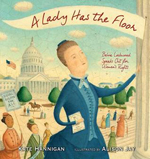 This picture book biography introduces young readers to Belva Lockwood, who spent her life fighting for women’s rights. Despite personal and social challenges, she was one of the first women to study law in the United States and, in 1879, became the first woman to argue a case before the Supreme Court. In 1884, Lockwood accepted the National Equal Rights Party’s nomination for president, running on a platform supporting women’s suffrage and equal rights for all. Hannigan’s lively text is peppered with quotes incorporated into Jay’s signature, crackled, folk art-style illustrations. Back matter includes an author’s note; a timeline of key events in the women’s rights movement, from Lockwood’s birth to present day; a bibliography; and source notes.
This picture book biography introduces young readers to Belva Lockwood, who spent her life fighting for women’s rights. Despite personal and social challenges, she was one of the first women to study law in the United States and, in 1879, became the first woman to argue a case before the Supreme Court. In 1884, Lockwood accepted the National Equal Rights Party’s nomination for president, running on a platform supporting women’s suffrage and equal rights for all. Hannigan’s lively text is peppered with quotes incorporated into Jay’s signature, crackled, folk art-style illustrations. Back matter includes an author’s note; a timeline of key events in the women’s rights movement, from Lockwood’s birth to present day; a bibliography; and source notes.
—CA
Let the Children March. Monica Clark-Robinson. Ill. Frank Morrison. 2018. Houghton Mifflin.
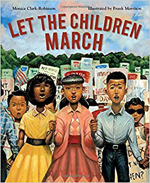 Debut author Monica Clark-Robinson’s free-verse picture book chronicles events around the May 1963 Children’s Crusade, following Martin Luther King Jr.’s call for participation in a nonviolent protest march in Birmingham, Alabama. When he urged the congregation to march, many adults were afraid of losing jobs, so young people offered to go. Although many of them were sprayed with water, arrested, and jailed, they persevered. The day after the march ended, Dr. King and white leaders negotiated a school desegregation agreement. Frank Morrison’s dramatic oil paintings offer a strong, emotional portrayal of events. A “Civil Rights and Children’s Crusade” timeline is displayed across front and back endpapers, and back matter includes an afterword, an artist’s statement, quote sources, a bibliography, and acknowledgments.
Debut author Monica Clark-Robinson’s free-verse picture book chronicles events around the May 1963 Children’s Crusade, following Martin Luther King Jr.’s call for participation in a nonviolent protest march in Birmingham, Alabama. When he urged the congregation to march, many adults were afraid of losing jobs, so young people offered to go. Although many of them were sprayed with water, arrested, and jailed, they persevered. The day after the march ended, Dr. King and white leaders negotiated a school desegregation agreement. Frank Morrison’s dramatic oil paintings offer a strong, emotional portrayal of events. A “Civil Rights and Children’s Crusade” timeline is displayed across front and back endpapers, and back matter includes an afterword, an artist’s statement, quote sources, a bibliography, and acknowledgments.
—NB
Ruby in the Ruins. Shirley Hughes. 2018. Candlewick.
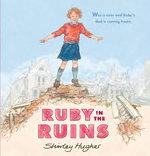 Ruby and her mum have survived the London Blitz and are awaiting Dad’s return from war. When they finally meet him at the train station, Ruby hardly recognizes him and doesn’t know what to say to him. But later, when Ruby is injured while playing with friends in a fenced-off bomb site, posted with “Danger! Keep Out” signs, and her dad comes to her rescue, Ruby knows exactly what to say: “Oh, Dad, I’m so glad you’re back!” Hughes’ detailed mixed-media illustrations beautifully set the scene for this gentle story of a family’s adjustment to life in postwar London.
Ruby and her mum have survived the London Blitz and are awaiting Dad’s return from war. When they finally meet him at the train station, Ruby hardly recognizes him and doesn’t know what to say to him. But later, when Ruby is injured while playing with friends in a fenced-off bomb site, posted with “Danger! Keep Out” signs, and her dad comes to her rescue, Ruby knows exactly what to say: “Oh, Dad, I’m so glad you’re back!” Hughes’ detailed mixed-media illustrations beautifully set the scene for this gentle story of a family’s adjustment to life in postwar London.
—CA
Ages 9–11
Betty Before X. Ilyasah Shabazz (with Renée Watson). 2018. Farrar, Straus and Giroux. 2018.
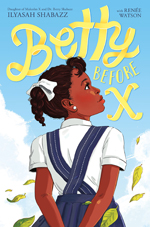 Cowritten by her daughter, Betty Before X shares the childhood story of Betty Shabazz, wife of Malcom X. When her beloved aunt and guardian dies, 7-year-old Betty is sent to Detroit to live with her mother and stepfamily. Feeling uncomfortable in her new home, she finds support in the local church, where she meets activist Helen Malloy, who encourages Betty and her best friend, Suesetta, to join the Housewives' League of Detroit and participate in the organization's boycott of businesses that refuse to hire or serve blacks. During the tumultuous 1940s, Betty begins to develop her “voice” for equality, a foundational skill for her lifelong activism—and discovered unexpected allies in her community in the fight against discrimination and violence toward blacks. Back matter includes an author’s note; “Detroit in the 1940s,” “Bethel AME Church,” a “Meet the Characters” sections; and a timeline.
Cowritten by her daughter, Betty Before X shares the childhood story of Betty Shabazz, wife of Malcom X. When her beloved aunt and guardian dies, 7-year-old Betty is sent to Detroit to live with her mother and stepfamily. Feeling uncomfortable in her new home, she finds support in the local church, where she meets activist Helen Malloy, who encourages Betty and her best friend, Suesetta, to join the Housewives' League of Detroit and participate in the organization's boycott of businesses that refuse to hire or serve blacks. During the tumultuous 1940s, Betty begins to develop her “voice” for equality, a foundational skill for her lifelong activism—and discovered unexpected allies in her community in the fight against discrimination and violence toward blacks. Back matter includes an author’s note; “Detroit in the 1940s,” “Bethel AME Church,” a “Meet the Characters” sections; and a timeline.
—NB
The Island at the End of Everything. Kiran Millwood Hargrave. 2018. Knopf/Random House.
 Twelve-year-old Ami lives on Culion, an island in the Philippines for people who have leprosy. Under orders that all healthy children are to be sent to an orphanage on a nearby island, “clean” Amihan is separated from her mother, who is suffering from an advanced stage of the disease. When Amihan learns that her mother is dying, she is determined to return to Culion to say goodbye to her. With the help of Mari, the one friend she has made at the Coron Orphanage, Amihan makes the trip in a small boat to return to Culion (known as the “island of the living dead” or “the island of no return” by those who were fearful and uninformed about leprosy). An author’s note provides background for the story and Hargrave’s choice to call Culion “the island at the end of everything.”
Twelve-year-old Ami lives on Culion, an island in the Philippines for people who have leprosy. Under orders that all healthy children are to be sent to an orphanage on a nearby island, “clean” Amihan is separated from her mother, who is suffering from an advanced stage of the disease. When Amihan learns that her mother is dying, she is determined to return to Culion to say goodbye to her. With the help of Mari, the one friend she has made at the Coron Orphanage, Amihan makes the trip in a small boat to return to Culion (known as the “island of the living dead” or “the island of no return” by those who were fearful and uninformed about leprosy). An author’s note provides background for the story and Hargrave’s choice to call Culion “the island at the end of everything.”
—CA
A Sky Full of Stars. Linda Williams Jackson. 2018. Houghton Mifflin.
 In this sequel to Midnight Without a Moon (2017), 13-year-old Rosa Lee Carter has decided to remain in 1955 Stillwater, Mississippi, where she and her younger brother, Fred Lee, are being raised on a sharecropper farm by a cruel grandmother and gentle grandpa. Emotions sizzle after Emmett Till’s killers are acquitted and as white renegades terrorize black families and those attempting to register blacks to vote. Cousin Shorty proposes they shoot at white folks’ windows to even the score, but Rosa is persuaded, instead, to participate in the first peaceful demonstration in town with her best friend Hallelujah Jenkins, the pastor’s son. Although actions exact great cost for all who protest, Rosa courageously forges her own path to be part of the movement for change. An author’s note provides an historical context.
In this sequel to Midnight Without a Moon (2017), 13-year-old Rosa Lee Carter has decided to remain in 1955 Stillwater, Mississippi, where she and her younger brother, Fred Lee, are being raised on a sharecropper farm by a cruel grandmother and gentle grandpa. Emotions sizzle after Emmett Till’s killers are acquitted and as white renegades terrorize black families and those attempting to register blacks to vote. Cousin Shorty proposes they shoot at white folks’ windows to even the score, but Rosa is persuaded, instead, to participate in the first peaceful demonstration in town with her best friend Hallelujah Jenkins, the pastor’s son. Although actions exact great cost for all who protest, Rosa courageously forges her own path to be part of the movement for change. An author’s note provides an historical context.
—NB
Ages 12–14
Hunger: A Tale of Courage. Donna Jo Napoli. 2018. Paula Wiseman/Simon & Schuster.
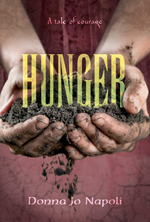 Set during the Irish Potato Famine in the fall of 1846, 12-year-old Lorraine’s family members are tenant farmers for an English lord in County Galway, where their close-knit community is falling ill as potatoes, the staple of their diet, are blighted for the second year. While gathering wild greens, Lorraine encounters Susanna, the spoiled and lonely young daughter of the manse, who entices Lorraine to attend her dolly tea parties that comes with delicious treats. When Lorraine’s little brother, Paddy, becomes gravely ill, Susanna devises a plan for Lorraine to gather eggs for him (which she secretly uses to feed her family and community). While many Irish abandon their country to survive, Lorraine and her family stay to fight for their rights and rebuild Ireland. Back matter includes a postscript, glossary, bibliography, and timeline of famines throughout history.
Set during the Irish Potato Famine in the fall of 1846, 12-year-old Lorraine’s family members are tenant farmers for an English lord in County Galway, where their close-knit community is falling ill as potatoes, the staple of their diet, are blighted for the second year. While gathering wild greens, Lorraine encounters Susanna, the spoiled and lonely young daughter of the manse, who entices Lorraine to attend her dolly tea parties that comes with delicious treats. When Lorraine’s little brother, Paddy, becomes gravely ill, Susanna devises a plan for Lorraine to gather eggs for him (which she secretly uses to feed her family and community). While many Irish abandon their country to survive, Lorraine and her family stay to fight for their rights and rebuild Ireland. Back matter includes a postscript, glossary, bibliography, and timeline of famines throughout history.
—NB
The Night Diary. Veera Hiranandani. 2018. Dial/Penguin.
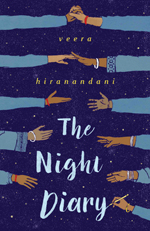 In 1947 India, Hindu Nisha and her twin brother, Amil, have just celebrated their 12th birthdays. Nisha decides to write to her Muslim mother, who died giving birth to her, in the diary that Kazi, their beloved cook, gifted to her. Nisha chronicles the next three months as her comfortable life in Mirpur Khas (now a part of Pakistan) is turned upside down after her country gains independence from the British and is split into two separate countries, new India and Pakistan, based primarily on people’s religions (Hindu or Muslim). But what if you have both Muslim and Hindu relatives and friends and must choose between them? After violence breaks out, Nisha, Amil, their father, and their elderly grandmother, as Hindus, flee on foot to their newly designated homeland of India across the border. Back matter includes an author’s note on the historical background for the story and a glossary of commonly used Indian and Pakistani words used in the book.
In 1947 India, Hindu Nisha and her twin brother, Amil, have just celebrated their 12th birthdays. Nisha decides to write to her Muslim mother, who died giving birth to her, in the diary that Kazi, their beloved cook, gifted to her. Nisha chronicles the next three months as her comfortable life in Mirpur Khas (now a part of Pakistan) is turned upside down after her country gains independence from the British and is split into two separate countries, new India and Pakistan, based primarily on people’s religions (Hindu or Muslim). But what if you have both Muslim and Hindu relatives and friends and must choose between them? After violence breaks out, Nisha, Amil, their father, and their elderly grandmother, as Hindus, flee on foot to their newly designated homeland of India across the border. Back matter includes an author’s note on the historical background for the story and a glossary of commonly used Indian and Pakistani words used in the book.
—NB
Voices from the Second World War: Stories of War as Told to Children of Today. 2018. Candlewick.
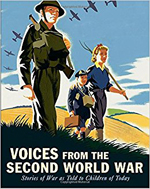 In this anthology individuals share accounts of their experiences during World War II. Many of the stories, first published in First News, were collected by children who interviewed elderly relatives and neighbors. Entries (arranged chronologically from the outbreak of the war to the bombing of Hiroshima) include moving stories of suffering, survival, and heroism of individuals who served in the military, women who met the demand to fill jobs on farms and factories and on the front lines as nurses, radio operators, and support staff in the armed forces, as well as children, including some who were part of the Kindertransport or survived internment in concentration camps. Although most of the interviewees are British, some are citizens of other Allies and Axis countries. Biographical sketches and black-and-white photographs of both the interviewers and interviewees accompany the stories. Back matter includes a subject index, an index of interviewees, and a glossary.
In this anthology individuals share accounts of their experiences during World War II. Many of the stories, first published in First News, were collected by children who interviewed elderly relatives and neighbors. Entries (arranged chronologically from the outbreak of the war to the bombing of Hiroshima) include moving stories of suffering, survival, and heroism of individuals who served in the military, women who met the demand to fill jobs on farms and factories and on the front lines as nurses, radio operators, and support staff in the armed forces, as well as children, including some who were part of the Kindertransport or survived internment in concentration camps. Although most of the interviewees are British, some are citizens of other Allies and Axis countries. Biographical sketches and black-and-white photographs of both the interviewers and interviewees accompany the stories. Back matter includes a subject index, an index of interviewees, and a glossary.
—CA
Ages 15+
Chasing King’s Killer: The Hunt for Martin Luther King, Jr.’s Assassin. James L. Swanson. 2018. Scholastic.
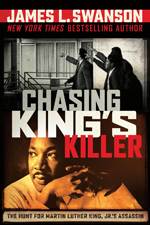 The Foreword, writtenby Congressman John Lewis, clearly establishes the impact of the tragic event that occurred on April 4, 1968, in Memphis, Tennessee. “After the assassination [of Martin Luther King, Jr.,] something died in America. The sense of hope, of optimism, of possibility was replaced by horror and despair.” James L. Swanson’s meticulously researched and documented narrative focuses on the murder of Dr. King and the manhunt for his assassin, James Earl Ray. He also provides information on Dr. King’s childhood in Atlanta and his work as a leader in the civil rights movement as well as background on convicted felon Ray, his escape from prison, his planning of the assassination, and his eventual apprehension. The epilogue ends with thought-provoking questions: “Where do we go from here? How long will it take? How long?” The abundance of quotations and captioned photographs add interest to the accessible and engrossing account. The extensive back matter includes source notes, bibliography, and an index.
The Foreword, writtenby Congressman John Lewis, clearly establishes the impact of the tragic event that occurred on April 4, 1968, in Memphis, Tennessee. “After the assassination [of Martin Luther King, Jr.,] something died in America. The sense of hope, of optimism, of possibility was replaced by horror and despair.” James L. Swanson’s meticulously researched and documented narrative focuses on the murder of Dr. King and the manhunt for his assassin, James Earl Ray. He also provides information on Dr. King’s childhood in Atlanta and his work as a leader in the civil rights movement as well as background on convicted felon Ray, his escape from prison, his planning of the assassination, and his eventual apprehension. The epilogue ends with thought-provoking questions: “Where do we go from here? How long will it take? How long?” The abundance of quotations and captioned photographs add interest to the accessible and engrossing account. The extensive back matter includes source notes, bibliography, and an index.
—CA
Nancy Brashear is Professor Emeritus of English from Azusa Pacific University, in Azusa, California. Carolyn Angus is former director of the George G. Stone Center for Children's Books, Claremont Graduate University, in Claremont, California.
These reviews are submitted by members of the International Literacy Association's Children's Literature and Reading Special Interest Group (CL/R SIG) and are published weekly on Literacy Daily.